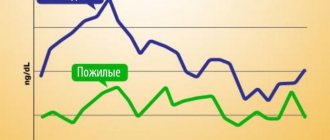Xanax (Xanax, Alprazolam, Alprazolam) is a brand name for the drug alprazolam, which belongs to a group of drugs called benzodiazepines. Prescribed for the treatment of neuropsychiatric disorders, panic attacks and social phobia.
When ingested, Xanax interacts with GABA receptors and slightly increases dopamine levels. GABA is gamma-aminobutyric acid, the main inhibitory and calming neurotransmitter. Increasing its levels leads to calmness and focus. Dopamine is a neurotransmitter responsible for motivation, pleasure and mood. Neurotransmitters themselves are transmitters of information between nerve cells.
Indications for use
- Neurotic reactive-depressive and mixed anxiety-depressive states, accompanied by sleep disturbances, decreased mood and energy, psychomotor agitation, loss of interest in the environment, impaired cognitive activity, somatic complaints, loss of appetite, changes in body weight, suicidal thoughts (low value, feelings of guilt) etc., including for organic and functional diseases (digestive, cardiovascular, dermatological), for somatic disorders, alcohol withdrawal syndrome;
- Anxiety states and neuroses, accompanied by worsening sleep, irritability, somatic disorders, restlessness, feelings of tension, anxiety;
- Phobia and panic attacks in patients with agoraphobia;
- Panic states, including those combined with symptoms of phobia.
What to do if signs of addiction appear
Specialized medical narcologists successfully treat all types of addiction, including drug addiction. Therefore, we will explain in detail to the patient’s relatives what it is, we will tell you what treatment methods we offer, and we will select an individual course. Therefore, if you realize that there is a persistent desire to take Xanax in a larger dose than you should, or you notice symptoms of addiction in a loved one, call us immediately +7 (495) 744-85-28.
We strongly recommend starting treatment in the hospital of our clinic. The fact is that first of all, the patient needs detoxification to completely cleanse the body of alprazolam. During this period, complications associated with disruption of the regulatory function of the nervous system cannot be excluded, and it is important that the addict is under round-the-clock medical supervision.
Subsequently, the main emphasis is placed on psychotherapy, hypnotic treatment methods, hardware influence, and physical therapy. We try to avoid prescribing sedatives and antidepressants, as such tactics can quickly provoke a relapse.
We work with confidentiality, even during inpatient treatment. Therefore, you don’t have to worry that information about the disease will go beyond the clinic. Do not delay treatment - the consequences may be irreversible!
The text was checked by expert doctors:
Head of the socio-psychological service of the Alkoklinik MC, psychologist Yu.P. Baranova, L.A. Serova, a psychiatrist-narcologist.
CAN'T FIND THE ANSWER?
Consult a specialist
Or call: +7 (495) 744-85-28
Call! We work around the clock!
Contraindications
Absolute:
- Thyroid diseases (0.5 mg tablets);
- Angle-closure glaucoma or predisposition to it;
- Acute respiratory failure;
- Chronic obstructive respiratory diseases with initial manifestations of respiratory failure;
- Myasthenia;
- Shock;
- Coma;
- Acute poisoning with alcohol (conditions accompanied by weakening of vital functions), sleeping pills and psychotropic drugs, opioid analgesics;
- Age up to 18 years;
- Pregnancy (especially the first trimester) and lactation;
- Hypersensitivity to the drug or other benzodiazepines.
Xanax is not intended to treat psychotic depression (it is not effective).
The drug should be used with extreme caution in cases of impaired renal and liver function, panic disorders, suicidal tendencies, and severe depression.
Why is alprazolam popular among drug addicts?
If taken not for the treatment of anxiety disorders, Alprazolam causes mild euphoria and a feeling of relaxation. This drug is often taken by celebrities or popular singers to experience creative inspiration.
The effects that drug addicts still experience from taking it:
- feeling of peace;
- calmness and physical comfort;
- self confidence.
Sometimes the drug causes excessive courage and inappropriate behavior. For example, a person crosses the road without following the rules or walks along the edge of a roof without fear of heights.
Directions for use and dosage
Xanax should be taken orally.
The optimal therapeutic dose is determined individually for each patient, depending on the severity of the symptoms of the disease and the severity of the clinical effect of the drug.
As a rule, standard doses are sufficient for most patients. In some cases, higher doses are required. Increases should be made carefully and gradually. If a high dose is prescribed, a larger amount of the drug should be taken before bedtime.
Periodically during treatment, the patient's condition should be reassessed and, if necessary, the dose adjusted.
If side effects develop, the dose of Xanax is reduced.
Treatment of anxiety and depressive disorders can last up to 6 months, panic disorders – up to 8 months.
Discontinuation of the drug should be carried out gradually, reducing the dose by no more than 0.5 mg every 3 days, in some cases even more slowly.
Tablets Recommended doses depending on indications:
- Anxiety: initial dose – 0.25-0.5 mg 3 times/day, maintenance dose – 0.5-4 mg/day, divided into several doses;
- Panic disorders: initial dose – 0.5 mg 3 times a day or 0.5-1 mg before bedtime. The maintenance dose is selected individually taking into account the severity of the clinical effect, increasing by no more than 1 mg every 3-4 days. The optimal average dose, according to clinical studies, is 5.7 ± 2.27 mg/day; in some cases, a maximum daily dose of 10 mg was required;
- Depression: initial dose – 0.5 mg 3 times a day, maintenance dose – 1.5-4.5 mg/day, divided into several doses.
For elderly people and weakened patients, the initial dose is 0.25 mg 2-3 times a day, the maintenance dose is 0.5-0.75 mg/day in several doses, and if necessary, the dose is gradually increased.
Retard tablets Recommended doses depending on indications:
- Anxiety: initial dose – 1 mg/day in 1 or 2 divided doses, maintenance dose – 0.5-4 mg/day in 1-2 divided doses;
- Panic disorders: initial dose – 0.5 mg 2 times a day or 0.5-1 mg before bedtime. The maintenance dose is selected individually taking into account the severity of the clinical effect, increasing by no more than 1 mg every 3-4 days. The optimal average dose, according to clinical studies, is 5-6 mg/day in 1-2 doses; in some cases, a maximum daily dose of 10 mg was required;
- Depression: initial dose – 1 mg/day in 1-2 divided doses, maintenance dose – 0.5-4.5 mg/day in 1-2 divided doses.
For elderly people, the initial dose is 0.5-1 mg/day in 1-2 doses, the maintenance dose is 0.5-1 mg/day, and if necessary, the dose is gradually increased.
Development of Xanax addiction
Under the influence of a drug, a person feels good, but when the effect wears off, the state of health becomes worse than it was before taking it. The natural urge is to take another pill to feel good again.
The second reason for addiction is withdrawal syndrome when stopping the drug.
Thinking that this is a medicine, a person will not suspect that he is “addicted” and has become a drug addict. Therefore, if he feels worse, he will take a pill. But they don’t help you heal - they “numb” the pain, and when the effect wears off, the pain returns and you need Xanax again.
Side effects
- Digestive system: drooling or dry mouth, constipation or diarrhea, decreased appetite, nausea, vomiting, heartburn, increased activity of liver transaminases and alkaline phosphatase, impaired liver function, jaundice;
- Central nervous system: at the beginning of treatment (especially in older people) - increased fatigue, drowsiness, dizziness, slowed motor and mental reactions, decreased ability to concentrate, unsteady gait, disorientation, ataxia; rarely - dystonic extrapyramidal reactions (uncontrolled movements, including the eyes), memory impairment, headache, impaired coordination of movements, tremor, depressed mood, weakness, confusion, euphoria, dysarthria, myasthenia gravis, depression; in some cases - paradoxical reactions (psychomotor agitation, confusion, irritability, hallucinations, aggressive outbursts, anxiety, agitation, insomnia, muscle spasms, fear, suicidal tendencies);
- Cardiovascular system: decreased blood pressure, tachycardia;
- Hemostasis system: agranulocytosis (sore throat, hyperthermia, chills, excessive fatigue or weakness), thrombocytopenia, neutropenia, leukopenia, anemia;
- Urinary system: dysmenorrhea, urinary incontinence or retention, decreased or increased libido, impaired renal function;
- Endocrine system: changes in body weight, menstrual irregularities and libido;
- Allergic reactions: skin rash, itching.
How does it work
Xanax (alprazolam), once in the body, is quickly absorbed, metabolized, distributed throughout the tissues of the body and absorbed by the brain. It then binds to GABA receptors, which reduce the activity of the central nervous system and the person experiences a whole combination of effects: anxiolytic, amnesic, anticonvulsant, hypnotic, muscle relaxant and sedative. Additionally, the rapid modulation of GABA receptors by Xanax results in increased firing of dopamine-secreting neurons. The latter creates the effect of pleasure and improves mood.
But Xanax is not the only powerful neurotransmitter. It also slows cerebral blood flow in the amygdala, pituitary gland, thalamus and hypothalamus, causing the following effects: sedation, poor coordination and slow reaction time. But in the nucleus accumbens—the area of the brain responsible for pleasure—Xanax increases cerebral blood flow. This leads to euphoria, impulsiveness, and also develops addiction .
In other words, Xanax causes feelings of mental and physical relaxation, drowsiness, and dullness. These effects appear half an hour after administration. Peak concentration is reached within an hour. The reasons for this rapid action are: pharmacokinetics (absorption, metabolism, distribution), pharmacodynamics (interaction with neurotransmitters) and the ability to activate various aspects of the brain (cerebral blood flow, neural communication, neuroelectric frequencies).
Short-term effects occur with normal use of the drug and are rather positive and calming in nature:
- Mental and physical relaxation.
- Calm.
- Loss of coordination.
- Slow speech.
Long-term effects occur with chronic use of sedatives:
- Cognitive deficits (dementia): poor memory, absent-mindedness, confusion, poor concentration and decreased intellectual ability.
- Psychomotor disorders.
- Addiction.
special instructions
Compared with patients suffering from chronic alcoholism or previously treated with anxiolytics or antidepressants, alprazolam is effective in lower doses in patients who have not previously taken drugs that affect the central nervous system.
Treatment of endogenous depression can be carried out by combining Xanax with antidepressants. In patients with depression, the drug can cause the development of manic and hypomanic states.
With long-term treatment with high doses of alprazolam, addiction and drug dependence may develop, especially in patients prone to drug abuse.
With abrupt withdrawal or rapid reduction of the dose of the drug, a withdrawal syndrome is observed, manifested by symptoms of varying severity - from insomnia and mild dysphoria to a severe syndrome with tremor, increased sweating, vomiting, cramps in the abdomen and skeletal muscles, and convulsions. Most often, withdrawal syndrome occurs in patients taking Xanax for a long time (more than 8-12 weeks).
During treatment, you should refrain from drinking alcoholic beverages, driving a car, and engaging in potentially hazardous activities that require high reaction speed and increased attention.
Xanax should not be used simultaneously with other tranquilizers.
What is Xanax used for in medicine?
These tablets are prescribed by doctors for the following indications:
- depression;
- social phobia;
- insomnia;
- senile tremor (muscle cramps);
- neuroses;
- in the treatment of alcohol withdrawal;
- for nausea due to chemotherapy.
It acts quickly and calms.
And even using Xanax according to a doctor’s prescription, strictly following the description in the instructions, can lead to serious health and mental problems. A huge list of contraindications and side effects, mention of addiction and overdose - all this speaks of the narcotic nature of these tablets.
For drug addicts, Xanax was an easily accessible pharmaceutical drug until it was available by prescription instead of just being ordered at the pharmacy.
Due to the narcotic effect of Xanax and despite the price, which is higher than other analogues, it is used more often than other drugs for other purposes.
Drug interactions
- Anticonvulsants and psychotropic drugs, ethanol, histamine H2 receptor blockers: the inhibitory effect of alprazolam on the central nervous system (CNS) increases;
- Antibiotics from the macrolide group: the clearance of alprazolam is reduced;
- Oral hormonal contraceptives: the half-life of alprazolam increases;
- Dextropropoxyphene: the concentration of alprazolam in the blood plasma increases, which may result in more pronounced CNS depression than when alprazolam is used with other benzodiazepines;
- Digoxin: the risk of developing intoxication with cardiac glycosides increases;
- Imipramine: its concentration in the blood plasma increases;
- Paroxetine, itraconazole, ketoconazole and, presumably, erythromycin: the effects of alprazolam are enhanced;
- Fluoxetine, fluvoxamine: the concentration of alprazolam in the blood plasma increases, increasing the risk of developing its side effects.
How to get rid of Xanax addiction
The Narconon program achieves success in 75% of cases. The steps of the program are aimed at different aspects of addiction and help to cope with the reasons for using. This includes special detoxification, unique exercises that teach you to face life, and gaining new knowledge that gives you a new outlook on life.
Thanks to the program, a person can start life from scratch - without cravings, regaining self-esteem, restoring relationships with others, and gaining the ability to enjoy life.
Share:
Wheels - what are they?
Drug "ice"
Who else does a tranquilizer help?
A course of Xanax is often prescribed to treat social phobia. This is the name given to a state of uncontrollable and uncontrollable fear associated with people’s fear of performing public actions. Some people can't speak publicly. Some people are afraid of the company of strangers. In more severe cases, social phobia can manifest itself in the fear of being in a crowd, riding in public transport, or even going outside. It is interesting that the majority of those suffering from this pathology are well aware of the causelessness of their fears. However, they cannot improve their condition on their own. Phobias can have very real manifestations:
- A sharp increase in heart rate, leading to shortness of breath and interruptions in breathing.
- Sweating.
- Chills.
- Frequent changes in skin color: from bright red to bluish-pale.
- Speech impairment.
- State of stupor.
“Xanax” (the instructions, reviews of doctors and people taking it confirm this) helps to successfully combat this condition.
In severe cases, a phobia attack can result in a panic attack or fainting.
Treatment
Drug dependence can be treated on an inpatient or outpatient basis. Therapy begins with discontinuation of the dose: then either the usual dose is reduced, or the drug is replaced with doses of barbiturates. At the same time, the consequences of drug withdrawal are eliminated: they relieve pain, cramps, and restore heart rhythm. The next stage is a course of psychotherapy, which helps to overcome psychological dependence. To consolidate the results of treatment, it is recommended to undergo a rehabilitation course.
If your loved ones need help in treating drug addiction, then sign up for a free consultation by calling the hotline of the Zdravnitsa professional treatment and rehabilitation center: 8-800-200-27-23 . Our specialists will select an effective treatment plan and accompany you throughout the course. We guarantee results if all our recommendations are followed.
Similar articles:
Drug amphetamine-phene
The effects of hallucinogenic mushrooms
How to make it easier to quit your hairdryer
Is TRIGAN-D a drug?
Types of dependencies
Related materials
00:05 — August 4, 2017
American drug plague
Doctors have doomed the United States to an epidemic of deaths from hard drugs.
Medical encyclopedias explain: Xanax, thanks to the active ingredient alprazolam, allows you to almost instantly relax, relieve tension, and suppress feelings of fear, anxiety and restlessness. You can quickly pop a small tablet under your tongue at the end of the working day and instantly forget about your strict boss and endless reports.
It would seem that the miraculous properties provided alprazolam, invented in the 1960s, with explosive popularity: today more than five percent of the adult population of the United States takes relaxation pills; it is on the list of the most frequently prescribed drugs in the country.
The tablets really work, but they have a number of unpleasant features. Firstly, tolerance to Xanax develops very quickly - to achieve the same relaxing effect, the body needs more and more alprazolam. Secondly, with uncontrolled use, addiction develops over time. Third, it lowers your breathing and heart rate—and if taken with opioid drugs (such as heroin or the equally popular fentanyl), the likelihood of death increases dramatically. Up to a third of all Xanax-related deaths occurred due to co-administration with opioids.
In addition, unlike many other substances that simply “knock out” the body when overdosed, benzodiazepines act differently: they erase memory, leaving the ability to act. Those who have taken too much Xanax can wander the streets for hours, attack people, rob and steal, get behind the wheel and cause accidents. Someone in such a helpless state himself becomes a victim of scammers and rapists.
Benzodiazepines help people cope with the relentless pace of life
Photo: Spencer Platt/Getty Images
Xanax is also known for its terrible withdrawal symptoms after a long-term overdose. Reddit users share: “I had visual hallucinations, I felt crazy, this is a constant bad trip (slang expression for a psychedelic crisis - approx. “Lenta.ru”
). It was as if there were blows in my head; I almost had an attack twice. I heard a loud bang in my head, saw a bright flash, my body jerked sharply, but nothing happened. It was like a flashbang grenade had exploded in my head. It's fucking scary."
“Dude, that sounds tough. Sometimes I have flashes in my head in my sleep, my body twitches so much that I either bite my tongue or kick the cat so that he flies out of bed... And this is four years later. This is not a joke,” another user responded, admitting that now, due to an addiction from the past, he cannot sleep without sleeping pills.
In a thread on a drug users forum where the problem of quitting certain substances is discussed, benzodiazepines (the generic name for drugs like Xanax) won by a huge margin: 244 votes for them versus 91 for methadone and 88 for heroin. Then, however, there is a similar severity of “withdrawal”: refusal of alcohol in those suffering from long-term severe alcoholism.
“I’m giving up because I don’t care about life; I hear voices in my head, they say stop it, but I found some Xanax in the bed, drank that shit and went back to sleep,” rapper Lil Peep wrote openly about his fascination with the drug. When he died in November 2017, traces of Xanax and fentanyl would be found in his blood. Substances with a similar structure to alprazolam - benzodiazepines - were found in the bodies of Elvis Presley, Michael Jackson, Heath Ledger and Whitney Houston.
Even the image of a Xanax tablet has entered popular culture - a tablet divided into four parts with the letters XANAX. A pill-shaped cake was ceremoniously cut by rapper Lil Pump after he reached a million followers on Instagram.
A XAN cake for celebration Last year this time I was a nobody now I'm rich bitch ESSKEETIT Btw I put 500 xanz in my cake
Photo published by @lilpump
The seemingly “clean” rapper Drake also spoke about his love for benzodiazepines: while visiting iLoveMakonnen, he boasted that he “takes zanami.” Then, however, he made an excuse that he had only embellished the truth: “I don’t drink this shit, but you do.”
Why is Xanax dangerous?
Reviews from both doctors and patients themselves are unanimous on one thing: the drug, with all its positive effects on the body, carries two dangers:
- Causes addiction.
- May be fatal.
Alprazolam belongs to the class of psychoactive substances that are most often used in medicine. The action begins almost immediately after taking the pill and lasts a long time. “Xanax” - reviews from doctors confirm this - does not cause drowsiness; on the contrary, many people feel a certain lift in mood after it. This is what determines the desire to take the medicine again and again.
Alprazolam and its analogues have one more unpleasant side, doctors say. It is effective and relieves panic attacks. The drug acts quickly and improves the condition so much that many people prefer to carry it with them all the time and take it even when their poor health is not caused by a vegetative crisis. Today, Alrazolam and its analogues are increasingly being equated with street drugs.
Attention! Taking the medicine with other tranquilizers and alcohol can cause death.
Who should not take Xanax?
Like any medicine, this drug has contraindications. You need to pay special attention to them: tablets affect the central nervous system, so their improper use can lead to particularly dangerous consequences. Who should not take Xanax? The instructions contain a detailed list of contraindications. The drug is not prescribed to people suffering from:
- Hypersensitivity to the components that make up the tablets, or to the main medicinal substance.
- Myasthenia.
- Glaucoma.
- Various breathing disorders.
- Liver failure.
- Motor disorders caused by improper functioning of the cerebellum or frontal lobes.
- Nocturnal respiratory arrest.
Some people who are addicted to alcohol believe that the best hangover cure is Xanax. Instructions for use and reviews from doctors categorically state the opposite: the medicine is contraindicated in case of alcohol, drug or drug poisoning. Combining this drug with alcohol can cause death. “Xanax” (doctors’ reviews of the drug indicate that experts are unanimous on this issue) should be taken with increased caution by patients with psychosis, depression and disorders of the brain structure of organic origin. In this case, the drug can cause a paradoxical reaction, aggravating symptoms up to suicidal tendencies. It is not recommended to use Xanax for pregnant women, teenagers and the elderly.




